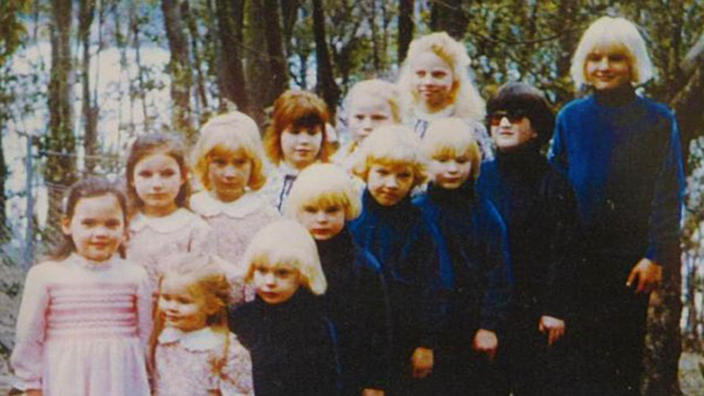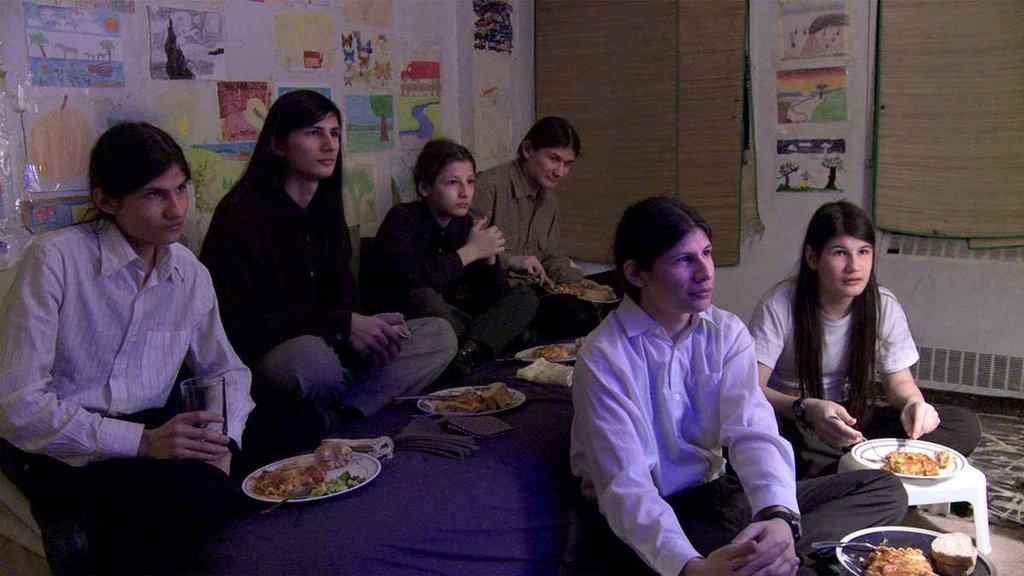In October 2019, between political trials in the U.S., unrest across South America, and a war exploding in north-east Syria, a bizarre story of a family being kept on a farm in the Netherlands nabbed international headlines. It all began when a 25-year-old man came into a pub in the Dutch village of Ruinerwold and, according to owner Chris Westerbeek, sat at the bar, ordered five beers, and drank them all, one right after the other. Sensing that something wasn’t quite right, Westerbeek struck up a conversation with the patron and, within a few minutes, heard a harrowing story. The man claimed to have escaped from a nearby farm, where him and his six brothers and sisters had been kept for almost a decade. Westerbeek called the police.
In the following weeks, the world would learn more about what police found on the farm property in Ruinerwold. The 25-year-old who’d made his way into Westerbeek’s bar—Jan van Dorsten—was the oldest of six siblings, aged 18 to 25, found living in a secret room on the property. It is believed that the family had spent the past nine years preparing for the “end of times,” and believed the rest of the world was doing the same.
Also found at the farm was the siblings’ father, 67-year-old Gerrit-Jan van Dorsten, and 58-year-old Josef Brunner, the handyman and caretaker. Police believe the men formed their own sect, and both were arrested on charges of depriving people of their liberty and money laundering; Van Dorsten was later charged with sexual assault of the eldest children. It was revealed that van Dorsten had previously been a member of the Unification Church, known as the Moonies, in the 1980s; when he split with the community, many assumed van Dorsten had gone on to create his own group. However, family members had feared van Dorsten dead after he failed to attend his parents’ funerals. The Austrian Brunner had also previously participated in a religious sect.
Details may still be emerging about the family from Ruinerwold, but we know one thing for certain: This case is far from the only of its kind. In fact, the van Dorsten family is part of an increasing in families who don’t just join a cult, but become one themselves.
According to experts, cults are marked by charismatic leaders who use isolationism, information and communication restriction, and a fear of the outside world to exert control over members. Those within a high-control group are usually expected to provide complete loyalty, with little room for questions, challenges, or critiques. With a group like that in Ruinerwold—that which is built into a family unit—the parent or parental figure fills the role of “cult leader.” Instead of recruiting individuals, members become children who may know no life outside of their parents’ particular worldview. This creates a dangerously unbalanced power dynamic—and as these stories show, the result can be even more devastating than what happened in Ruinerwold.

The Family
A half-century before the six siblings were found preparing for the end of days in Ruinerwold, a doomsday cult in Australia—known as The Family—made international news when female leader, Anne Hamilton-Byrne, was accused of illegal adoptions and child abuse. Born Evelyn Edwards in 1921, Hamilton-Byrne was the oldest of seven children and spent her childhood in and out of orphanages as her mother was a paranoid schizophrenic and her father struggled to care for the kids on his own. As an adult, Hamilton-Byrne gave birth to a single biological child and lost her first husband in a car accident before becoming a yoga teacher; it was her New Age blend of yoga, Eastern, and Western religious principles that earned her a following.
As her group grew, it came to include the manager of a local psychiatric hospital, which treated many of its patients with LSD. As The Family evolved, the hospital became a tool of both recruitment and drug access. Between 1968 and 1975, Hamilton-Byrne and her husband Bill acquired 14 children through illegal adoptions or from followers, who were encouraged to give their children over to the woman who soon started to call herself the female incarnation of Jesus Christ. The children were given falsified legal documents, the last name Hamilton-Byrne, and were told that Anne was their biological mother; some children were even grouped into sets of twins or triplets. To further emphasize the familial structure, Hamilton-Byrne dressed the kids in matching outfits and dyed their hair a matching platinum blonde. She insisted that the end of days was coming and that The Family was a “master race” that would survive. The children were beaten, drugged, and subjected to extensive training that Hamilton-Byrne claimed was in preparation for the apocalypse.
The Family first came onto the police’s radar in 1980, when 10-year-old Kim Halm was kidnapped by her mother, a member of The Family. But it wasn’t until 1987 that the group would begin to fall apart when Sarah Moore, formerly Sarah Hamilton-Byrne, was expelled from the group for resisting the rules and rituals and went to police. The property was raided in 1987, and all children were removed from the Hamilton-Byrnes’s care. The couple fled Australia and eluded police for six years, until they were arrested by the FBI in 1993 in the Catskills in New York. They were extradited to Australia and charged with conspiracy to defraud and to commit perjury; they pled guilty to making a false declaration and were fined $5000 each.
The Turpins
In the case of the Ruinerwold farm, there’s no knowing what would’ve happened had the eldest not made his way to that bar. In this case, the truth was similarly revealed only after a victim had the courage to come forward. On January 14, 2018, two children fled their Perris, California home through a window—one turned back, but a 17-year-old girl continued on and was able to successfully call 911. When police met her, she showed them photos from inside the home, where she and her 12 siblings had been imprisoned for years by their parents, David and Louise Turpin.
When police met her, she showed them photos from inside the home, where she and her 12 siblings had been imprisoned for years by their parents, David and Louise Turpin.
Though early family photos of the Turpins depict a TLC-worthy sea of matching dresses, conservative outfits, and outgrown hair, the reality that met police at the home in Perris was far from picture perfect. The thirteen siblings, aged two through 29, had been living in a house of horrors where they were beaten, strangled, chained to their beds, and starved. Police found the siblings dirty, skittish, and malnourished; one child was shackled to their bed and two others had just been released. The children reported being allowed to eat only once per day and shower just once each year.
In the wake of the discovery, the couple was arrested and charged but pled not guilty to all charges until February 22, 2019. At this time, the couple changed their pleas to guilty on fourteen felony counts, including cruelty to an adult dependent, child cruelty, torture, and false imprisonment. On April 19, 2019, the couple was sentenced to life imprisonment with the possibility of parole after 25 years. All thirteen children received medical care in the months following their removal from the home, and the younger children have since been placed in foster homes.

The Wolfpack
In 2015, a high-control family took center stage at the Sundance Film Festival, where documentary The Wolfpack took home the U.S. Documentary Grand Jury Prize. Directed by Crystal Moselle, the film follows the seven Angulo siblings, who for 14 years have been raised, homeschooled, and virtually entirely confined to their family’s apartment on the Lower East Side of New York. Their father Oscar is a devotee of Hare Krishna, and gave his six sons and one daughter Sanskrit names, encouraged them to grow their hair long, and taught them to avoid the outside world at all costs. This ideology was further reinforced their mother Susanne, who spent almost a decade and a half homeschooling her children in the same four bedroom apartment where the family lived the entirety of their lives. Some years, the family would be allowed to leave nine times in 12 months—in others, they’d be allowed to leave the apartment just once or twice all year long.
Among what often felt like a dim existence, a bright spot for the siblings—especially the six brothers—was the family’s 5,000-film collection. They may not have been allowed to explore the world firsthand, but movies became a way for the Angulo children to learn about what life was like beyond the walls of their apartment. Or at least, to try. When Moselle discovered the brothers on a New York street, they wore matching Ray-Ban sunglasses reminiscent of Reservoir Dogs, apparently surprised to find that real life wasn’t exactly like it is in the movies. In fact, the Angulo brothers occupied their abundant spare time not only watching movies, but memorizing and recreating them scene-for-scene within the confines of their apartment.
But in January 2010, things changed when one of the middle brothers, 15-year-old Mukunda, decided to take a walk around the block against their father’s wishes. Soon, all six brothers began to explore Manhattan—that is how they eventually met Moselle, and became the subjects of her documentary. In the years since, Susanne and the siblings have become estranged from Oscar and many of the brothers have even adopted non-Sanskrit names.
The Harts
Unlike many of the other families on this list, the Hart family didn’t maintain control by staying out of the public eye. As it was, Jennifer and Sarah Hart and their six adopted children often found themselves directly in front of it. In 2014, their 12-year-old son Devonte was thrust into the spotlight—and the media—when he was photographed in what became known as “the hug felt ‘round the world.” The image was taken at a Ferguson protest in Portland, and depicts the Black Devonte, who’d been at the event with a “Free Hugs” sign, crying as he embraces a White police officer. The Hart family became a fixture at protests, music festivals, and rallies and, in 2016, was invited to sit directly behind Bernie Sanders at a televised event where a bird landed on the presidential candidate’s shoulder. These and other events were chronicled by Jennifer in frequent, effusive social media posts about her family.
But there was turmoil lurking just below the surface. Starting in 2008, the Harts were the subject of a number of child abuse accusations that followed them across the next decade and multiple states. They moved from Minnesota to Oregon to Washington, suspiciously pulling their children out of school and fleeing when suspicions were inevitably raised; Jennifer and Sarah were being investigated by Clark County, Washington for child abuse when they once again made news in 2018. But this time, it wasn’t because of the family’s public service or progressive persona.
On March 26, 2018, the Hart family was traveling in an SUV when they were involved in a fatal crash off Highway 1 in Mendocino County, California. There were no survivors, and it quickly became clear to authorities that Jennifer, who’d been driving at the time, had purposefully driven the vehicle off a 100-foot cliff. Jennifer’s toxicology report showed she was over the legal limit for alcohol, while Sarah and two of the children were found to have antihistamines that cause drowsiness in their system. In the hours leading up to the crash, Sarah’s phone showed searches about drowning, hypothermia, and no-kill shelters for dogs. As with cults that have ended in mass suicide, the public has learned more about the Hart family in the wake of their deaths including the extent to which Jennifer and Sarah worked to create a public facade that hid the disturbing abuse, neglect, and control of the children they’d vowed to love and protect.

















